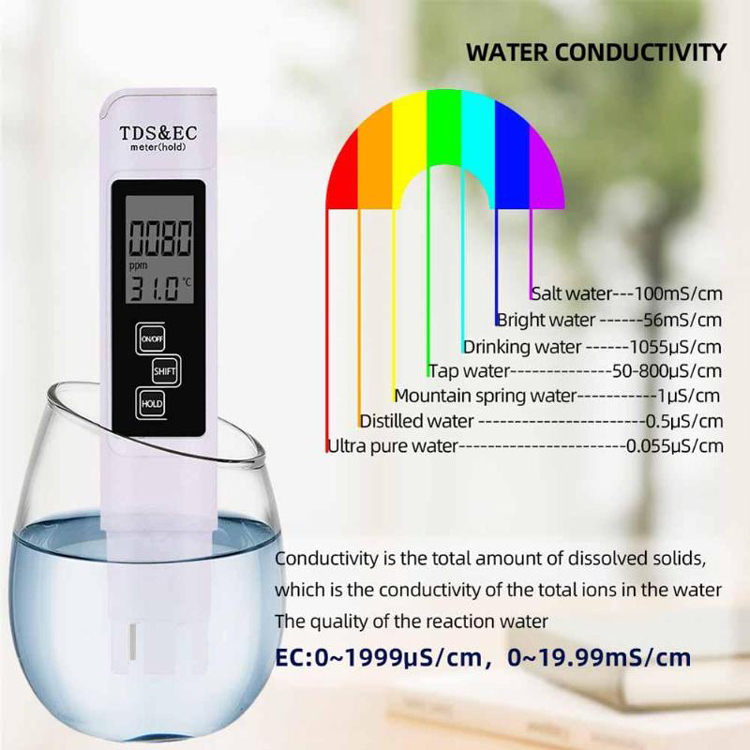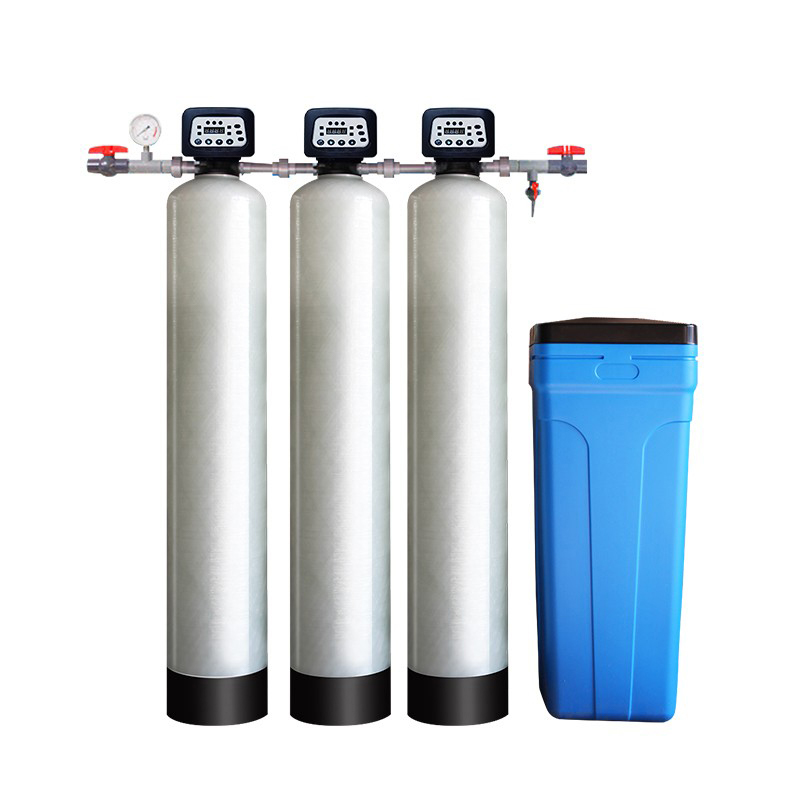 Raw water.
Raw water. Refers to untreated water: In a broad sense, water before entering the water treatment process is also called raw water of the water treatment process. For example, water sent from the water source to the clarification tank for treatment is called raw water.
Softened water. Refers to water in which the hardness (mainly calcium and magnesium ions in water) is removed or reduced to a certain extent. During the softening process, only the hardness of water is reduced, while the total salt content remains unchanged
Desalted water. Refers to water in which salts (mainly strong electrolytes soluble in water) are removed or reduced to a certain extent. Its conductivity is generally 1.0-10.0μs/cm, resistivity (25℃) 0.1--1000000Ω.cm, and salt content is 1.5mg/L.
Pure water. Refers to strong electrolytes and weak electrolytes (such as SiO2, C02, etc.) in water. Water that has been removed or reduced to a certain degree. Its conductivity is generally: 1.0-0.1μs/cm, resistivity 1.0--1000000Ω.cm. Salt content <1mg/l.
Ultrapure water. Refers to water in which the conductive medium in the water is almost completely removed, and the non-dissociated gas, colloid and organic matter (including bacteria, etc.) are also removed to a very low level. Its conductivity is generally O.1-0.055μs/cm, resistivity (25℃)>10×1000000Ω.cm, and salt content <0.1mg/l. Ideal pure water (theoretically) has a conductivity of 0.05μs/cm and a resistivity (25℃) of 18.3×1000000μs/cm.

1. Demineralized water refers to the finished water obtained by removing suspended matter, colloids, inorganic cations, anions and other impurities in water by various water treatment processes. Demineralized water does not mean that all salts in the water are completely removed. Due to technical reasons and water production cost considerations, demineralized water is allowed to contain trace impurities according to different uses. The fewer impurities in the demineralized water, the higher the water purity.
2. The hardness of water is mainly composed of cations: calcium (Ca2+) and magnesium (Mg2+) ions. When the raw water containing hardness passes through the resin layer of the exchanger, the calcium and magnesium ions in the water are adsorbed by the resin, and sodium ions are released at the same time. In this way, the water flowing out of the exchanger is softened water with hardness ions removed. When the resin adsorbs calcium and magnesium ions to a certain saturation, the hardness of the outlet water increases. At this time, the water softener will automatically regenerate the failed resin according to the predetermined program, and use a higher concentration of sodium chloride solution (brine) to pass through the resin to restore the failed resin to sodium type resin.
Desalted water

Desalted water refers to the finished water obtained by removing suspended matter, colloids, inorganic cations, anions and other impurities in water through various water treatment processes. Desalted water does not mean that all salts in the water are completely removed. Due to technical reasons and water production cost considerations, desalted water is allowed to contain trace impurities according to different uses. The fewer impurities in the desalted water, the higher the water purity. In production practice, people use different names to distinguish the purity of desalted water based on the concept of desalted water. For example, in boiler feed water treatment, water with a conductivity of less than 3uS/cm (25℃) is usually called distilled water, water with a conductivity of less than 5us/cm (25℃) and a SiO2 content of less than 100ug/L is called primary demineralized water, water with a conductivity of less than 0.2us/cm (25℃) and a SiO2 content of less than 20ug/L is called secondary demineralized water, and water with a conductivity of less than 0.2us/cm (25℃), a Cu, Fe, and Na content of less than 3ug/L, and a SiO2 content of less than 3ug/L is called high-purity water or ultrapure water.
The salt content in water is the reason why water conducts electricity. The greater the salt content of water, the smaller the resistance and the stronger the conductivity. In other words, the strength of water conductivity is an inevitable reflection of the high or low salt content of water. The conductivity of water can be easily measured with a conductivity meter. The conductivity of water can be used to measure the purity of water. Because water temperature has a great influence on conductivity, generally, for every 1°C increase in water temperature, the conductivity increases by about 2%, so the water temperature should be indicated in the conductivity. The conductivity of various ions is different, so water with the same conductivity may also have different types and contents of impurities. At 25°C, the conductivity generated by only H and OH- ionized in water is 0.555us/cm, which is the theoretical limit of the purity of desalted water. Conductivity and resistivity are reciprocal, that is, conductivity = 1/resistivity, for example, 0.2us/cm = 5MΩ.cm
The above-mentioned definitions of desalted water and water quality standards have not yet been completely unified, especially the differences between different industries are obvious. For example, some industries call water with a conductivity of less than 0.1F6/cm (25°C), a pH of 6.8-7.0, and water with other impurities and bacteria removed as high-purity water. In. In some industries, desalted water is also called pure water, desalted water, salt-free water and purified water.
Demineralized water contains little or no minerals and is made by distillation, reverse osmosis, ion exchange, or a combination of these methods.
Studies on heart disease and cancer have shown that healthy water is water with a certain hardness and a certain TDS. Demineralized water, as an artificially softened or purified water, contains no calcium, magnesium, and has very low total dissolved solids, making it unhealthy to drink.
Yet many people drink it for their own reasons, usually thinking something like this: I know I should drink water, but it's contaminated with various chemicals such as chlorine and toxic metals, so it's not safe at all, so I bought a distiller or reverse osmosis unit, which will remove all the substances from the water and make the water drinkable. Does this sound familiar?
When we think like this, we only see part of the picture, not the whole picture. We only emphasize the harmful components of the water, but we don't understand the beneficial components. In order to drink healthy water, we must look at the problem from both sides: we need to significantly reduce or eliminate the harmful substances, but still retain the beneficial minerals in the water. In most cases, a proper filtration system or the right bottled mineral water can do the job - demineralized water cannot!
Those who support drinking desalted water claim that inorganic minerals in water (such as calcium, magnesium, selenium, etc.) cannot be metabolized and therefore will not cause health problems, but this is not true.
In fact, minerals in water are easier and better absorbed by the human body than those in food! Dr. John Sorenson (Western medicine chemist), an authority on mineral metabolism theory, said: "Minerals in drinking water are well absorbed." He found that the ratio of major metal elements involved in metabolism to non-major elements is greatly affected by the number of major elements in the water; if the required major elements are met, there will be little or no absorption of non-major elements, and non-major elements will be excreted.
For example, if the calcium and magnesium content in water is high and the lead content is low, the human body will choose the major elements (calcium and magnesium) and excrete the non-major element (lead); but if the calcium and magnesium content is also low, the cells may choose the non-major element lead, which will cause protein or enzyme dysfunction. If this happens, the protein or enzyme may become toxic.
The distiller and reverse osmosis device can produce softened desalted water without any minerals. The effect of any harmful substances in this soft water will be amplified. A small amount of harmful substances in desalted water will have a more harmful and negative effect on our health than the same amount of harmful substances in hard water. Therefore, for completely different reasons, drinking contaminated water and desalted water will cause harm to our health.

Softened water working principle:
The hardness of water is mainly composed of cations: calcium (Ca2+) and magnesium (Mg2+) ions. When the raw water containing hardness passes through the resin layer of the exchanger, the calcium and magnesium ions in the water are adsorbed by the resin, and sodium ions are released at the same time. In this way, the water flowing out of the exchanger is softened water with hardness ions removed. When the resin adsorbs calcium and magnesium ions to a certain saturation, the hardness of the water increases. At this time, the water softener will automatically regenerate the failed resin according to the predetermined program, and use a higher concentration of sodium chloride solution (brine) to pass through the resin to restore the failed resin to sodium type resin.

Features
Soft water reduces or avoids the formation of scale and is suitable for washing and bathing. In addition, it also avoids the problems of energy waste and reduced efficiency of water-using equipment caused by scale in water pipes. The main features of soft water:
(1) Prevent water pipes, water heaters, coffee machines, humidifiers, steam irons, bathtubs, shower heads, flush toilets and other household appliances from accumulating scale, frequent blockages, and low thermal efficiency.
(2) Hairdressing, dandruff removal and itching relief, soft hair, natural hairstyle. Skin care, bathing skin is soft and smooth, and body dandruff is significantly reduced. Makeup, the skin does not feel tight, and it is very easy to put on and remove makeup.
(3) Brewing coffee and tea leaves, the taste is unique and the flavor is pure. Growing flowers, extending the flowering period, green leaves without spots, and flowers are gorgeous. Raising fish, preventing various fish diseases.
(4) Extending the shelf life of tofu, making soy milk more fragrant, bean sprouts do not need growth hormones, and grow strong. Washing vegetables, removing pesticide components, and extending the shelf life of vegetables. Cooking rice, shortening the time, making rice grains soft and smooth, and pasta not easy to expand. Cooking, maintain the natural taste and nutrients of vegetables.
(5) Effectively inhibit fungi, promote wound healing, reduce the incidence of constipation, gastrointestinal and stone diseases.
(6) Washing clothes, prevent static electricity, discoloration, deformation, wash dishes, clean without water stains, improve the gloss of utensils. Clean the kitchen and bathroom, strong decontamination and odor removal.
(7) Save funds, reduce water equipment and water pipe maintenance costs by more than 60%, reduce hot water fuel costs by more than 30%, and reduce detergent purchase costs by more than 50%.
Softened water is applicable to a wide range of fields: bathroom, kitchen, laundry, heating, boiler, central air conditioning equipment water supply, beauty and health care, etc.





 Application of Reverse Osmosis Technology in Industrial Ultrapure Water Production
Application of Reverse Osmosis Technology in Industrial Ultrapure Water Production
 Small Industrial RO Systems Keep Breaking Down? 5 Common Failures + Solutions to Streamline Maintenance
Small Industrial RO Systems Keep Breaking Down? 5 Common Failures + Solutions to Streamline Maintenance
 Knowledge Summary on Water Softening and Water Softening Equipment
Knowledge Summary on Water Softening and Water Softening Equipment
 From Turbid to Clear: The Working Secrets of Reverse Osmosis Systems
From Turbid to Clear: The Working Secrets of Reverse Osmosis Systems